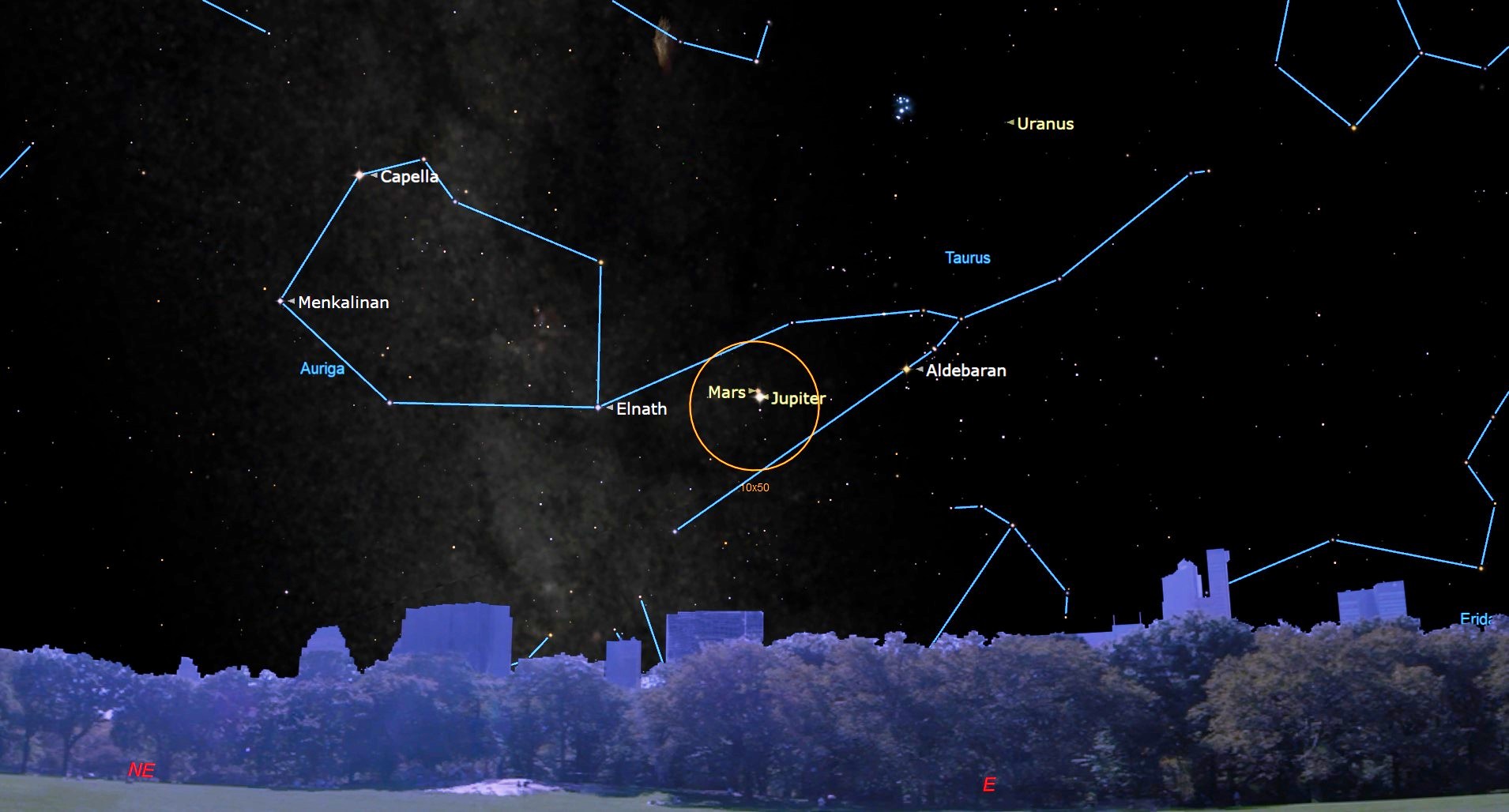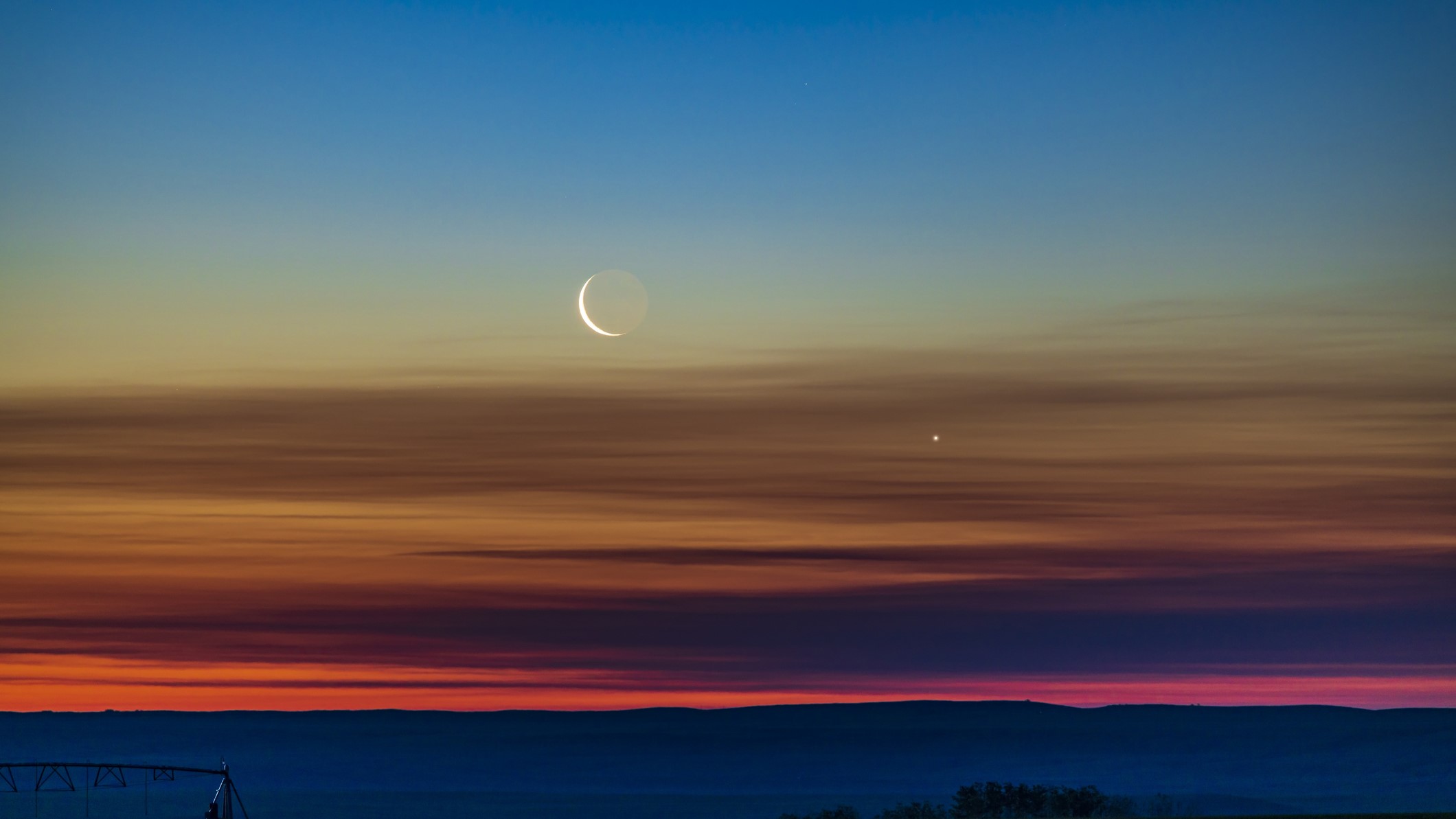Update
TUESDAY, AUGUST 13 – MOON AND ANTARES (EVENING)

Look south just after sunset and you will see a waxing gibbous moon, now more than half lit and shining brightly. Look to the upper left and you may be able to Antaresa reddish star that is now at its best. It is the brightest star in the iconic constellation Scorpio and about 555 Light years from the Solar System. If you squint, you will see the reddish hue more easily. The later you look, the closer the Moon and Antares will be. From the South Pacific, the Moon will occult (block) Antares, according to In-The-Sky.org. —Jamie Carter
WEDNESDAY, AUGUST 14 – JUPITER AND MARS IN CONJUNCTION (BEFORE DAWN)

It’s worth getting up early because it’s one of the closest planetary conjunctions of the year. It’s visible in the southeast from about 2 a.m. local time until sunrise. Mars And Jupiter only a third of a degree apart (a third of the width of your little finger when you stretch out your arm). Jupiter, however, at Size -2.2, will be about 15 times brighter than Mars, with a magnitude of +0.8. Although the two planets appear closest this morning, it’s worth looking at the pair on the mornings before and after to get a similar view. — Jamie Carter
MONDAY, AUGUST 12 – PERSEIDEN METEOR SHOWER (OVERNIGHT)

This morning, the climax of the annual Perseid meteor shower took place, but don’t despair if you missed it because of work or bad weather. Although you won’t get another chance to see 50-75 “shooting stars” in an hour – as was possible last night – it’s wise to look up into the sky late at night tonight (preferably after midnight early Tuesday, August 13) when the skies are clear to catch a healthy number of bright Meteors. If you cannot escape to a really dark sky, keep artificial light out of your direct line of sight, because there is always the possibility of seeing one or two particularly bright “fireballs.” The later you look, the higher the shower’s radiance will be in Perseus will be visible in the northeastern sky. — Jamie Carter
You can also Watch the Perseid meteor shower online for free with this livestream, moderated by astrophysicist Gianluca Masi from the Virtual Telescope Project. The livestream starts at August 12, 9:00 p.m. EDT (August 13, 1:00 a.m. GMT).
MONDAY, AUGUST 12 – FIRST QUARTER MOON (EVENING)

Tonight, the moonThe east side appears half-illuminated — the so-called first quarter phase — when it makes its 90-degree angle from the the sun in its monthly orbit around the Earth. As the first quarter moon always rises around noon and sets around midnight, it begins to bleach the evening night sky, making it harder to see stars (and “shooting stars” from the Perseid meteor shower). Still, it’s a beautiful sight to the naked eye. – Jamie Carter
SUNDAY, AUGUST 11 – MONDAY, AUGUST 12: PERSEID METEORS PEAK (BEFORE DAWN)

There’s no better time to spot shooting stars in the Northern Hemisphere than tonight. At its peak, the annual Perseid meteor shower can produce about 60 meteors per hour visible in the night sky. The radiant point (where the meteors appear to come from) will be the constellation Perseus, which will rise in the northeastern sky around midnight.
Meteor showers can often be marred by strong moonlight, but not the Perseids this year, as the first quarter moon sets around midnight. Look to the skies in the early hours of Monday for the best chance of spotting shooting stars, although light pollution and sky clarity will make a big difference. If possible, avoid light pollution — at least 40 miles from a major urban area is advisable — but no matter where you watch from, make sure you have no artificial light in your field of vision. Sit back, relax in a lounge chair, keep warm, and take regular breaks. Never look at your smartphone; its white light will destroy your eyes’ dark adaptation, which takes about 20 minutes to develop, and even a single second of white light can destroy it.
If you can’t look for Perseids in person, you can Watch it live online here on Space.com Courtesy of the Virtual Telescope Project. First The livestream starts at August 11, 9:00 p.m. EDT (August 12, 1:00 a.m. GMT) The second starts at August 12, 9:00 p.m. EDT (August 13, 1:00 a.m. GMT) This coincides with the expected peak activity of the Perseid meteor shower.
FRIDAY, AUGUST 9 – SATURDAY, AUGUST 10 – CRESCENT, SPICA, ANTARES AND THE MILKY WAY (AFTER SUNSET)

About a quarter of the Moon’s Earth-facing side is now illuminated by the Sun. In two nights, it will appear on either side of Spica. Arcturus, in the constellation Boötes, will appear directly above the pair, while to the south, the Milky Way will rise after dark. To see the arc of our galaxy, however, you’ll need to be far away from light pollution. – Jamie Carter
THURSDAY, AUGUST 8 – CRESCENT MOON, VENUS AND SPICA (AFTER SUNSET)

Here’s another chance to see the crescent moon dominating the evening sky after sunset, while Venus stubbornly glows close to the western horizon. Look at the dark left side of the moon. Can you make out any details? Since there’s no sunlight shining directly on it, it should be dark, right?
The light you can see is called “planetshine,” “Earthshine,” or “Da Vinci glow.” It is sunlight shining on the Earth and reflecting off the Moon. It is easiest to see in a crescent Moon that is a few days old. — Jamie Carter

WEDNESDAY, AUGUST 7 – CRESCENT MOON, VENUS AND SPICA (AFTER SUNSET)

A brighter, more distinct crescent moon will be about halfway between Venus at the lower right and the bright star Spica at the upper left tonight. Spica is one of the 20 brightest stars in the night sky and the brightest star in the constellation Virgo. – Jamie Carter



